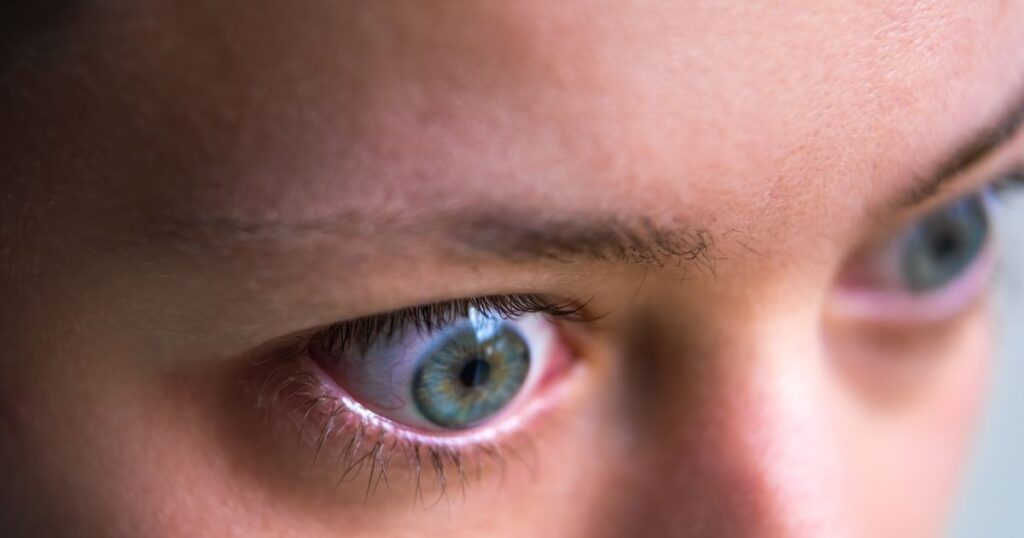
Thyroid Eye Disease (TED), also known as Graves’ orbitopathy or Graves’ ophthalmopathy, is a rare autoimmune disorder that affects the muscles and fat surrounding the eyes. It is often linked to thyroid disorders, particularly Graves’ disease, and Hashimoto’s disease. TED commonly manifests in individuals with hyperthyroidism, an overproduction of thyroid hormones, which not only affects overall health but also has distinct effects on the eyes. Symptoms include bulging eyes (proptosis), redness, irritation, dryness, and in severe cases, vision problems like double or blurred vision.
TED typically affects individuals aged 40-60 and is more prevalent in women than men. Despite its rarity, with an estimated 16 cases per 100,000 women and 2.9 per 100,000 men, early diagnosis and treatment are crucial to preventing severe vision impairment. If left untreated, TED can progress, leading to more serious eye health issues, including optic nerve damage.
One of the hallmark symptoms of TED is strabismus (crossed eyes), but the condition can also cause a variety of other vision problems, significantly impacting quality of life. Regular consultation with an ophthalmologist or endocrinologist is essential for managing symptoms, improving eye health, and preventing complications.
Phases of Thyroid Eye Disease
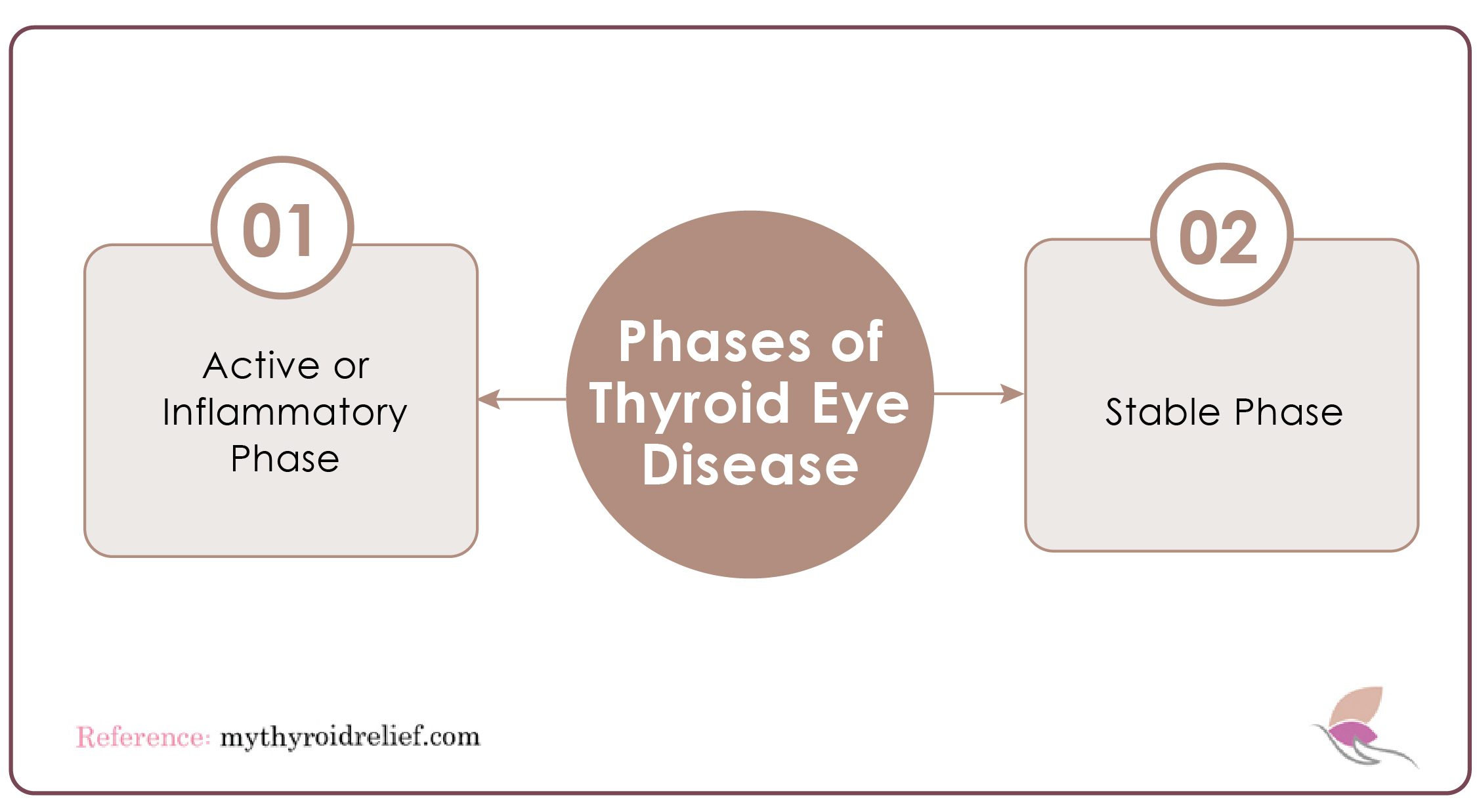
There are two phases of TED:
1. Active or Inflammatory Phase
This phase is characterized by an ongoing immune response that attacks the tissues and muscles around the eyes. The most common symptoms include bulging eyes (proptosis), redness, dryness, light sensitivity, and difficulty moving the eyes. Swelling in the eyelids and the orbital area may also occur, leading to increased pressure on the eye muscles and, in some cases, double vision or pain.
The active phase typically lasts between six months to two years, and early intervention is essential to reduce the risk of permanent damage. Medications such as corticosteroids or other anti-inflammatory drugs may be used during this phase to control the swelling and discomfort.
2. Stable Phase
Once the active inflammation reduces, the disease moves into the stable phase. While inflammation decreases, some symptoms, like bulging eyes or eyelid retraction, may persist. This phase can last indefinitely, with residual effects from the initial inflammation potentially causing ongoing issues, including vision problems.
During the chronic phase, corrective surgeries may be considered to address long-term damage, such as orbital decompression surgery to relieve eye pressure or eyelid surgery to correct retraction. While symptoms stabilize, regular follow-up care with an ophthalmologist and endocrinologist remains critical to ensure no further progression of the disease.
Symptoms of Thyroid Eye Disease

Thyroid Eye Disease (TED) symptoms can vary significantly between individuals, and while some may experience mild discomfort, others might face more severe complications. Most people notice gradual changes in their vision and eye appearance, which tend to worsen over time. TED primarily affects the muscles and tissues around the eyes, leading to the following symptoms:
- Bulging eyes (proptosis): Swollen muscles behind the eyes push the eyeballs forward, giving the characteristic “staring” look. This can make the eyes more vulnerable to dryness and irritation.
- Double vision: The swelling of eye muscles can cause misalignment, resulting in double vision (diplopia). This can affect daily activities like reading or driving.
- Eyelid retraction: In TED, the eyelids may pull back from the surface of the eyes, leaving them more exposed and giving the appearance of a wide-eyed stare. This makes it difficult to blink or close the eyes fully, worsening dryness.
- Dry eyes: Due to eyelid retraction and incomplete blinking, the eyes are prone to becoming excessively dry, leading to irritation, grittiness, and discomfort.
- Excessive tearing: As a reaction to dryness or irritation, the eyes may produce more tears, which can result in watery eyes.
- Pain or discomfort around the eyes: The inflammation of the tissues around the eyes can cause soreness, pressure, or aching sensations, especially when moving the eyes.
- Sensitivity to light (photophobia): Eyes affected by TED may become hypersensitive to bright light, making it uncomfortable to be in well-lit environments or outdoors.
- Swelling or puffiness around the eyes: Inflammation can cause the surrounding tissues to swell, giving a puffy appearance.
Causes of Thyroid Eye Disease (TED)
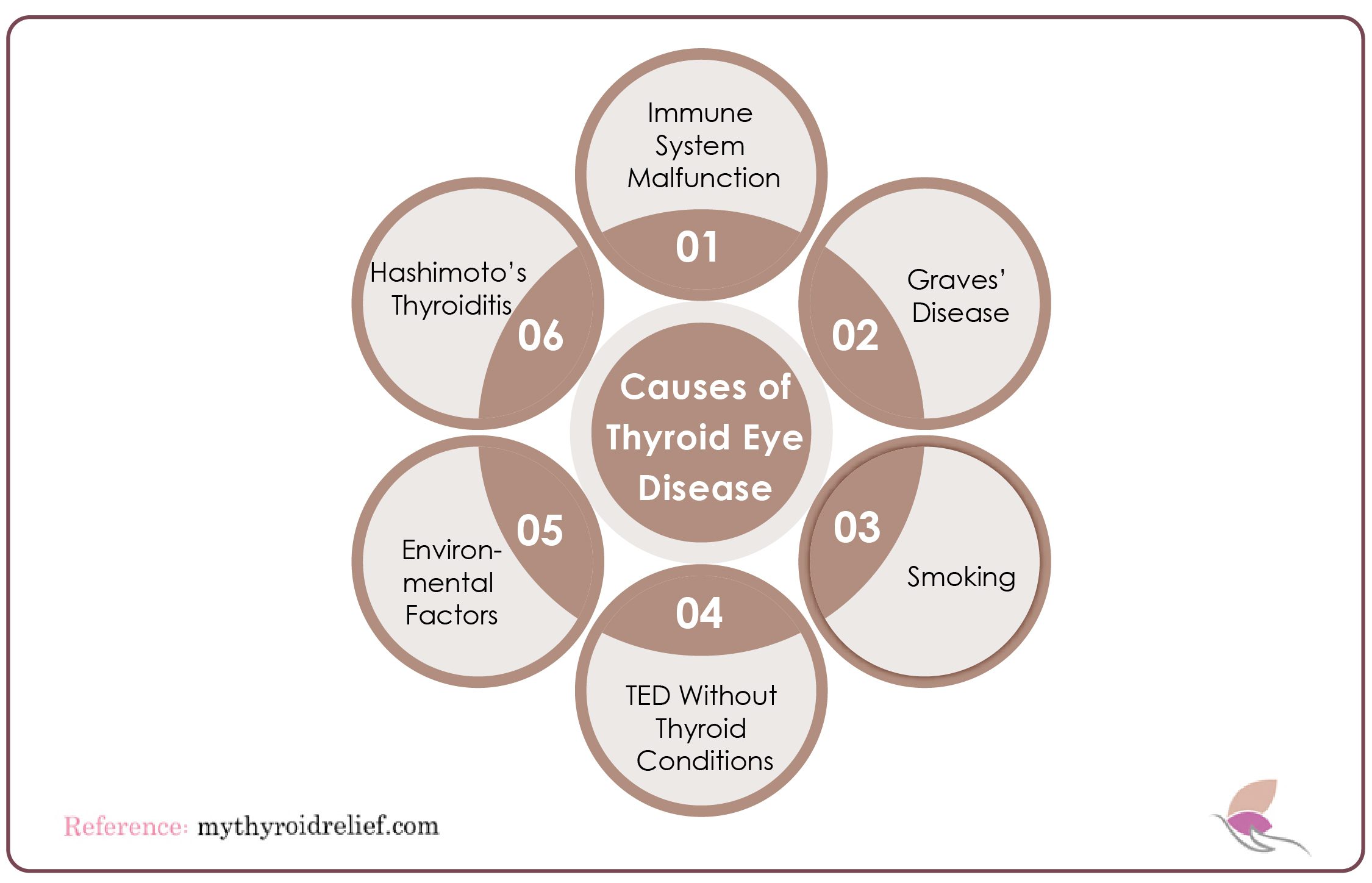
Thyroid Eye Disease (TED), also known as Graves’ orbitopathy, primarily affects people with thyroid disorders. Although the exact cause of TED is not fully understood, several factors contribute to its development.
1. Graves’ Disease
The most common cause of Thyroid Eye Disease is Graves’ disease. This autoimmune disorder causes the immune system to attack the thyroid gland, leading to the overproduction of thyroxine. This results in hyperthyroidism. In people with TED, the immune system also mistakenly attacks the muscles and fatty tissues around the eyes. As a result, the eyes become inflamed, swollen, and start to bulge—these are classic symptoms of TED.
2. Immune System Malfunction
In many cases, the immune system’s attack extends beyond the thyroid gland, affecting the tissues around the eyes. This can happen even when the thyroid appears to function normally. The inflammation caused by this immune response can lead to eye bulging (proptosis), redness, dryness, and discomfort. Both hyperthyroidism and, in rare cases, hypothyroidism can be linked to this immune system malfunction.
3. TED Without Thyroid Conditions
While Graves’ disease is the primary cause of TED, some people develop the condition without any thyroid dysfunction. In these cases, the exact cause is unclear but is believed to involve an autoimmune response. About 10% of people with TED do not have a thyroid condition, making diagnosis more challenging.
4. Hashimoto’s Thyroiditis
In rare instances, TED can occur in individuals with Hashimoto’s thyroiditis, an autoimmune disorder that leads to hypothyroidism. While this is less common than with Graves’ disease, it demonstrates that TED can be linked to other thyroid-related autoimmune disorders.
5. Smoking
Smoking is a significant risk factor for TED. Research shows that smokers are more likely to develop severe symptoms of TED than non-smokers. Smoking worsens the autoimmune response and reduces the effectiveness of TED treatments. Quitting smoking can greatly improve the management of the disease.
6. Environmental Factors
Environmental factors such as exposure to toxins and pollutants may also play a role in the development of TED. These factors can increase oxidative stress in the body, which may worsen inflammation and eye symptoms. Although less impactful than smoking, reducing exposure to environmental toxins can help manage the severity of TED symptoms.
Thyroid Eye Disease and Blepharitis
There is a strong correlation between Thyroid Eye Disease (TED) and blepharitis, a common condition that involves inflammation of the eyelids. Both TED and blepharitis share overlapping symptoms such as redness, pain, swelling, dryness, and irritation around the eyes. The inflammation in both conditions affects the tissues surrounding the eyes, leading to discomfort and potential vision problems if left untreated. Blepharitis often occurs when the oil glands near the base of the eyelashes become clogged, which can worsen the symptoms of TED.
For individuals with TED, the likelihood of developing blepharitis is significantly higher due to the underlying autoimmune response that contributes to both conditions. Inflammation and immune system dysfunction in TED can trigger or exacerbate blepharitis, making it more challenging to manage eye health. The presence of both conditions can create a vicious cycle of eye irritation. The inflammation from blepharitis can aggravate the already sensitive eye tissues affected by TED, increasing discomfort and worsening symptoms like dryness and light sensitivity.
Treatment for both TED and blepharitis generally involves anti-inflammatory medications, such as corticosteroids or topical antibiotics, to control swelling and irritation. In severe cases, oral antibiotics may be prescribed to treat blepharitis. Additionally, practicing good eyelid hygiene, such as regularly cleaning the eyelids with a warm compress, can help alleviate symptoms and prevent flare-ups.
It is crucial to address both TED and blepharitis together, as managing one condition without the other may lead to prolonged symptoms and complications. If you experience persistent eye discomfort, pain, or irritation, consulting with an ophthalmologist is essential for proper diagnosis and treatment.
Diagnosis of Thyroid Eye Disease (TED)

Diagnosing Thyroid Eye Disease (TED) involves a detailed assessment by an ophthalmologist or endocrinologist. This process typically includes a combination of clinical evaluations and specialized tests to determine the severity of the disease and to guide treatment decisions. A comprehensive approach is essential since early diagnosis is key to preventing complications.
Below are the diagnostic methods commonly used:
1. Thyroid Antibody Test
A thyroid antibody test is crucial for detecting autoimmune disorders like Graves’ disease and Hashimoto’s disease, both of which are often associated with TED. This blood test identifies abnormal antibodies, such as thyroid-stimulating immunoglobulin (TSI), that indicate an autoimmune response. High levels of these antibodies suggest that the immune system may be attacking both the thyroid gland and the tissues around the eyes, contributing to TED. This test is essential for confirming the autoimmune nature of the condition.
2. Imaging Tests
Imaging is important for visualizing the extent of tissue damage and swelling caused by TED. MRI (Magnetic Resonance Imaging) and CT (Computed Tomography) scans provide detailed images of the soft tissues, muscles, and fat around the eyes. These tests are particularly valuable in detecting the thickening of the eye muscles, tissue inflammation, and optic nerve compression. Identifying optic nerve involvement is critical, as it can lead to vision loss if untreated.
3. Biopsy
In rare cases, a biopsy may be necessary to confirm a TED diagnosis or to exclude other possible conditions. A small sample of tissue is taken from the affected area around the eyes and analyzed under a microscope. The biopsy helps to determine the type of inflammation and the extent of tissue damage, guiding the selection of appropriate treatment options. This procedure is particularly useful when there is uncertainty about the diagnosis or if other eye conditions are suspected.
4. Thyroid Function Tests
Thyroid function tests measure levels of thyroid-stimulating hormone (TSH), triiodothyronine (T3), and thyroxine (T4) to assess whether the thyroid is functioning normally. In TED, abnormal thyroid hormone levels, particularly in patients with hyperthyroidism or hypothyroidism, are common. Understanding the thyroid’s activity is essential for managing TED since the thyroid’s overactivity or underactivity directly impacts the eyes.
5. Visual Field Test
The visual field test measures a patient’s peripheral and central vision to identify any loss caused by TED. Swelling and inflammation can sometimes compress the optic nerve, leading to blind spots or reduced peripheral vision. Early detection of optic nerve involvement is critical for preventing permanent vision damage.
6. Ocular Examination
A comprehensive ocular examination helps identify key symptoms of TED, such as bulging eyes (proptosis), eyelid retraction, dryness, and double vision (diplopia). This examination includes testing the eyes’ movement in all directions, checking visual acuity, and measuring how far the eyeballs have protruded. It also helps to assess the degree of swelling around the eyes.
7. Optical Coherence Tomography (OCT)
Optical Coherence Tomography (OCT) is a non-invasive imaging technique that provides high-resolution cross-sectional images of the retina and optic nerve. This test is vital for detecting subtle changes in the optic nerve, such as swelling or early signs of compression, which could indicate complications from TED. OCT is particularly useful for tracking disease progression and adjusting treatment plans as needed.
8. Exophthalmometry
Exophthalmometry is used to measure the degree of eye protrusion (proptosis), which is one of the hallmark symptoms of TED. The test involves using a special device to quantify how far the eyes have bulged forward. Tracking these measurements over time helps doctors evaluate the progression of TED and determine whether treatments are effective.
Preventing Thyroid Eye Disease (TED)

Preventing Thyroid Eye Disease (TED) can be challenging due to its autoimmune nature, but certain lifestyle changes and proactive health management can lower your risk and help control symptoms. By adopting healthy habits and staying vigilant with your medical care, you can reduce the severity of TED and its impact on your vision.
Here are some key steps:
1. Regular Eye Exams
Frequent checkups with an ophthalmologist are crucial, especially if you have a thyroid disorder like Graves’ disease. Routine exams allow for early detection of TED symptoms, enabling timely intervention. Catching TED early can help prevent complications such as optic nerve damage or vision loss.
2. Follow Thyroid Treatment Plans
Adhering to your prescribed thyroid treatment plan is essential in reducing the risk of TED. Whether you are on antithyroid medications, beta-blockers, or other therapies, keeping your thyroid hormone levels stable helps lower the likelihood of TED development. Close collaboration with your endocrinologist ensures effective management of thyroid conditions, thereby minimizing TED progression.
3. Quit Smoking
Smoking is a significant risk factor for TED. It not only increases the risk of developing the disease but also worsens its severity. Research shows that smokers with Graves’ disease are more prone to severe eye symptoms. Quitting smoking can reduce inflammation, support immune health, and lower your risk of TED significantly.
4. Maintain a Healthy Diet and Exercise Routine
A balanced diet rich in nutrients, along with regular physical activity, strengthens your immune system and supports thyroid function. Focus on foods high in antioxidants, vitamins, and minerals, like leafy greens, fruits, and whole grains. Also, exercise can help regulate metabolic function and reduce inflammation, both of which are beneficial in managing autoimmune conditions.
For those with Graves’ disease, limiting foods high in iodine, such as seaweed, shellfish, and iodized salt, is essential. Excess iodine can stimulate thyroid overactivity, potentially worsening symptoms.
5. Manage Stress
Chronic stress can exacerbate autoimmune conditions like TED by impairing immune function. Practicing stress-management techniques such as yoga, meditation, deep breathing, or mindfulness can help support overall well-being and reduce the risk of TED flare-ups. Incorporating relaxation techniques into your daily routine is beneficial for balancing mental and physical health.
6. Reduce Exposure to Environmental Toxins
Exposure to environmental toxins, like chemicals, heavy metals, and pollutants, may trigger autoimmune responses. Reducing your exposure to these toxins can help mitigate the risk of developing autoimmune conditions, including TED. Opt for organic foods, natural cleaning products, and filtered water when possible to minimize exposure.
7. Take Supplements to Support Thyroid Health
Certain vitamins and supplements may help support thyroid function and immune health. Selenium and Vitamin D are known to aid in managing autoimmune thyroid disorders. Before starting any supplementation, consult with your healthcare provider to ensure they are appropriate for your condition and won’t interfere with your current treatments.
8. Limit Iodine Intake
If you are at risk of hyperthyroidism or have been diagnosed with Graves’ disease, controlling your iodine intake is vital. Too much iodine can trigger an overproduction of thyroid hormones, exacerbating thyroid-related issues and increasing your risk for TED. Avoiding iodine-rich foods, such as iodized salt, seafood, and dairy, can help maintain thyroid health and reduce TED risk.
Treatments for Thyroid Eye Disease (TED)
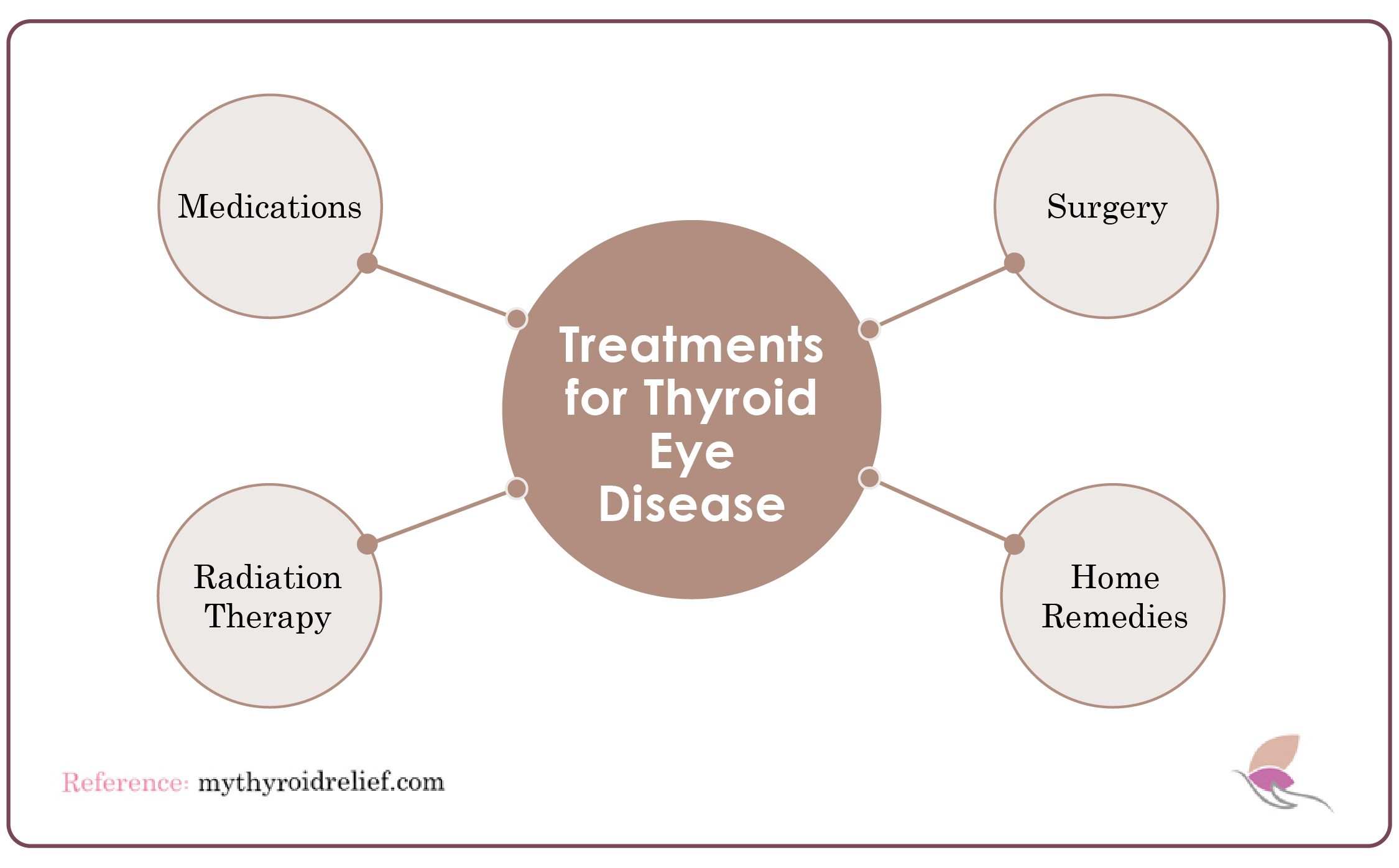
Treatments for Thyroid Eye Disease (TED) aim to protect your eyes, reduce inflammation, and prevent vision loss, especially during the active (inflammatory) phase. Depending on the severity of TED and your individual needs, doctors may recommend one or a combination of the following treatments to manage symptoms and preserve your vision:
1. Medications
Corticosteroids are the first-line treatment, effectively decreasing inflammation, swelling, and pain around the eyes during the active phase of the disease. For more severe cases, immunosuppressants are used to lower inflammation and slow disease progression by suppressing the immune system. Individuals with an overactive thyroid may be prescribed antithyroid drugs to stabilize hormone levels, which can help alleviate TED symptoms. Beta-blockers, typically used for high blood pressure, can reduce symptoms like bulging eyes and eyelid retraction by addressing thyroid overactivity.
Low-dose Naltrexone (LDN) is an emerging treatment that helps ease inflammation and slow disease progression by regulating the immune response, particularly in those with Graves’ disease. A groundbreaking option is TEPEZZA (Teprotumumab), a monoclonal antibody treatment that targets a protein involved in TED development. It has been shown to reduce eye bulging, improve vision, and alleviate inflammation.
2. Surgery
In advanced cases of Thyroid Eye Disease (TED), surgical intervention may become necessary to address severe eye problems and restore vision. One common procedure is orbital decompression surgery, which aims to create more space in the eye socket by removing excess bone, muscle, or fat. This operation alleviates pressure on the optic nerve, which can reduce eye bulging and improve both vision and the overall appearance of the eyes.
Another surgical option is eyelid surgery, particularly important for patients experiencing eyelid retraction—a prevalent symptom of TED. This condition can leave the cornea exposed, increasing the risk of dryness and injury. Eyelid surgery adjusts the position of the eyelids, ensuring better coverage and protection of the eyes, which enhances comfort for the patient.
For those affected by double vision, eye muscle surgery may be required. This procedure involves repositioning the eye muscles to correct any misalignment, thereby improving eye coordination and reducing visual disturbances. Overall, these surgical options are critical for managing advanced TED cases and significantly contribute to restoring both function and quality of life for patients.
3. Radiation Therapy
Radiation therapy is a vital treatment option for managing Thyroid Eye Disease (TED), especially in cases with severe inflammation unresponsive to medications. Two primary types are used: External Beam Radiation Therapy and Internal Radiotherapy (brachytherapy).
External Beam Radiation Therapy directs high-energy beams at the eyes over several weeks to reduce inflammation and prevent further damage. In contrast, Internal Radiotherapy involves placing a small radioactive pellet near affected tissues, emitting low-level radiation to target inflamed cells while sparing healthy tissue.
This method typically requires fewer sessions and has generally mild side effects. Although some patients may experience dry eyes, skin irritation, or fatigue, these effects usually resolve after treatment. Overall, radiation therapy is crucial in managing TED effectively when other treatments are insufficient.
4. Home Remedies
Managing Thyroid Eye Disease (TED) involves not only medical treatments but also effective home remedies that can provide relief. Applying warm compresses to the eyes can reduce swelling and soothe discomfort while lubricating eye drops help combat dryness and irritation. Wearing sunglasses protects sensitive eyes from sunlight and wind, and prism glasses can alleviate double vision by improving visual alignment.
For those whose eyelids don’t fully close during sleep, taping them shut can prevent corneal damage and dryness. Stress management is essential, as stress can trigger flare-ups; practices like yoga and meditation can help. Additionally, avoiding environmental toxins, such as chemicals and heavy metals, can reduce the risk of worsening symptoms. By integrating these home remedies, individuals can enhance comfort and improve their overall well-being while managing TED.
Vitamins and Supplements for Thyroid Eye Disease
These vitamins and supplements can play a significant role in managing Thyroid Eye Disease (TED) by supporting overall eye health and helping to reduce inflammation. Various vitamins and minerals can have a positive impact on symptoms and the overall well-being of individuals with TED.
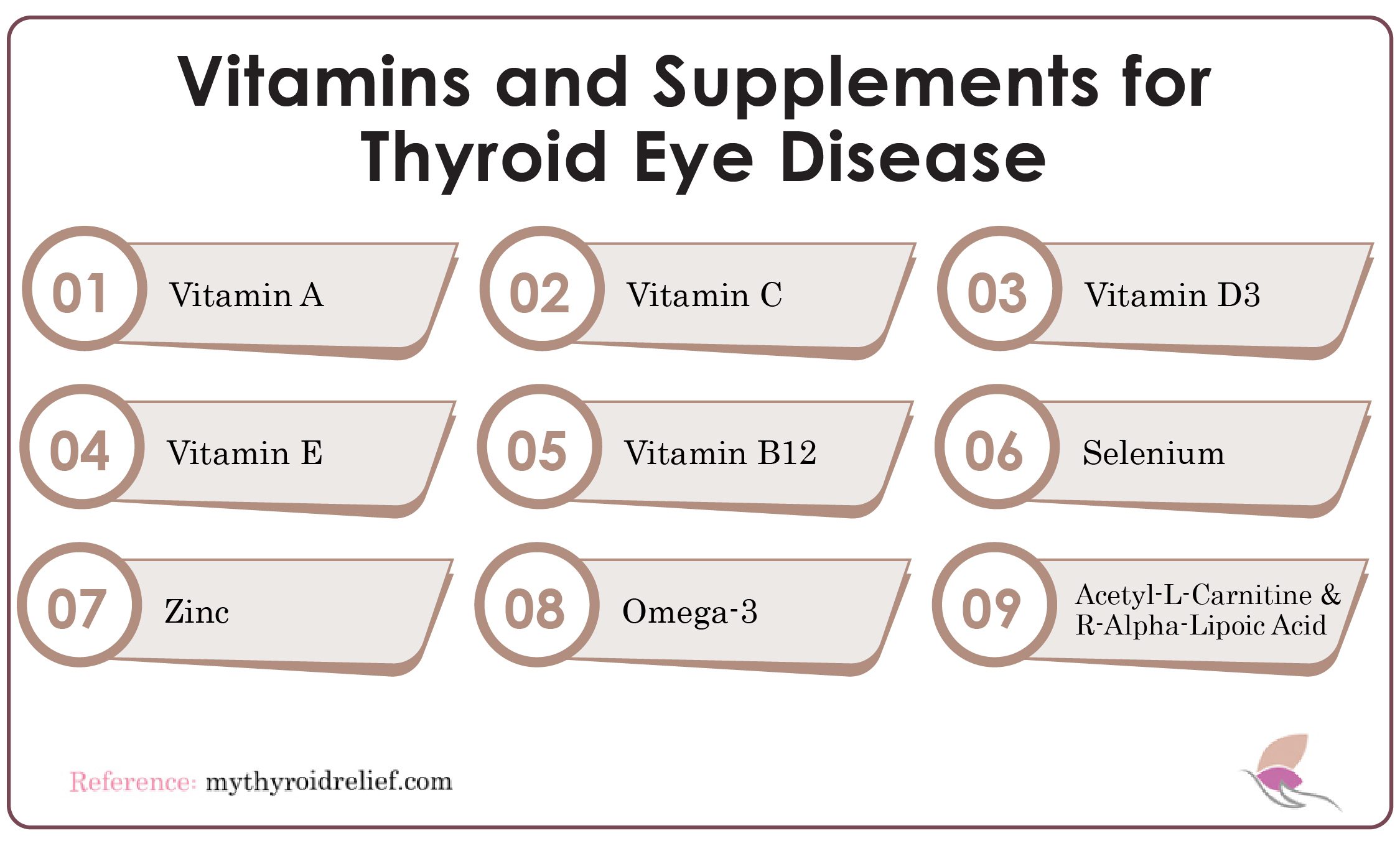
1. Vitamin A
This vitamin is essential for maintaining good vision and supporting immune function. It protects the eyes from dryness and irritation, which can be common in TED. Adequate vitamin A intake can enhance tear production, improving comfort for those with dry eye symptoms. Sources of vitamin A include carrots, sweet potatoes, spinach, and liver.
2. Vitamin C
This vitamin is a powerful antioxidant that reduces inflammation, improves circulation, and aids in collagen production. Collagen is crucial for healthy skin and connective tissues, and its role in promoting collagen synthesis is particularly important for maintaining the structural integrity of the eye. Foods rich in vitamin C include citrus fruits, strawberries, bell peppers, and broccoli.
3. Vitamin D3
This is vital for immune function and helps regulate calcium levels in the body. It may improve overall thyroid function and immune response, which is particularly important for individuals with autoimmune disorders. Research indicates that vitamin D deficiency is common in these individuals, making it essential to maintain adequate levels through sun exposure, fortified foods, or supplements.
4. Vitamin B-12
This is crucial for nerve health and red blood cell production, supporting overall energy levels and potentially alleviating some symptoms associated with TED. It also contributes to neurological function, which may be beneficial for those experiencing visual disturbances. Good sources of vitamin B-12 include meat, fish, dairy products, and fortified cereals.
5. Vitamin E
This is another antioxidant with anti-inflammatory properties, protecting the eyes from damage caused by free radicals, which can contribute to eye health. Its ability to support cellular health makes it an essential nutrient for overall wellness, found in foods like nuts, seeds, and green leafy vegetables.
6. Selenium
This is an essential trace mineral important for thyroid function. It helps reduce inflammation and supports the production of thyroid hormones. Found in soil and various foods such as Brazil nuts, seafood, and grains, selenium may also help protect against oxidative stress. However, more research is needed to confirm its effects in selenium-rich areas.
7. Zinc
This is vital for immune function, cell growth, and wound healing. It protects the eyes from UV damage and supports overall ocular health. Zinc plays a role in producing melanin, the pigment that protects the eyes from sunlight. Good dietary sources of zinc include meat, shellfish, legumes, and seeds.
8. Omega-3 Fatty Acids
These are essential for heart health and cognitive function. These are found in fish oil supplements and fatty fish like salmon, mackerel, and herring. Omega-3s may help reduce inflammation in the eyes and lower the risk of developing Graves’ disease. Incorporating omega-3s into your diet can also promote overall cardiovascular health, benefiting blood flow to the eyes.
9. L-Carnitine or Acetyl L-Carnitine
This amino acid plays a critical role in energy metabolism. Some studies suggest that L-carnitine may help reverse symptoms of Graves’ disease and hyperthyroidism. Consult with your doctor to determine if it’s a suitable option for you, as its potential to improve energy levels can be especially helpful for individuals experiencing fatigue due to their condition.
Dietary Considerations for Thyroid Eye Disease (TED) Management
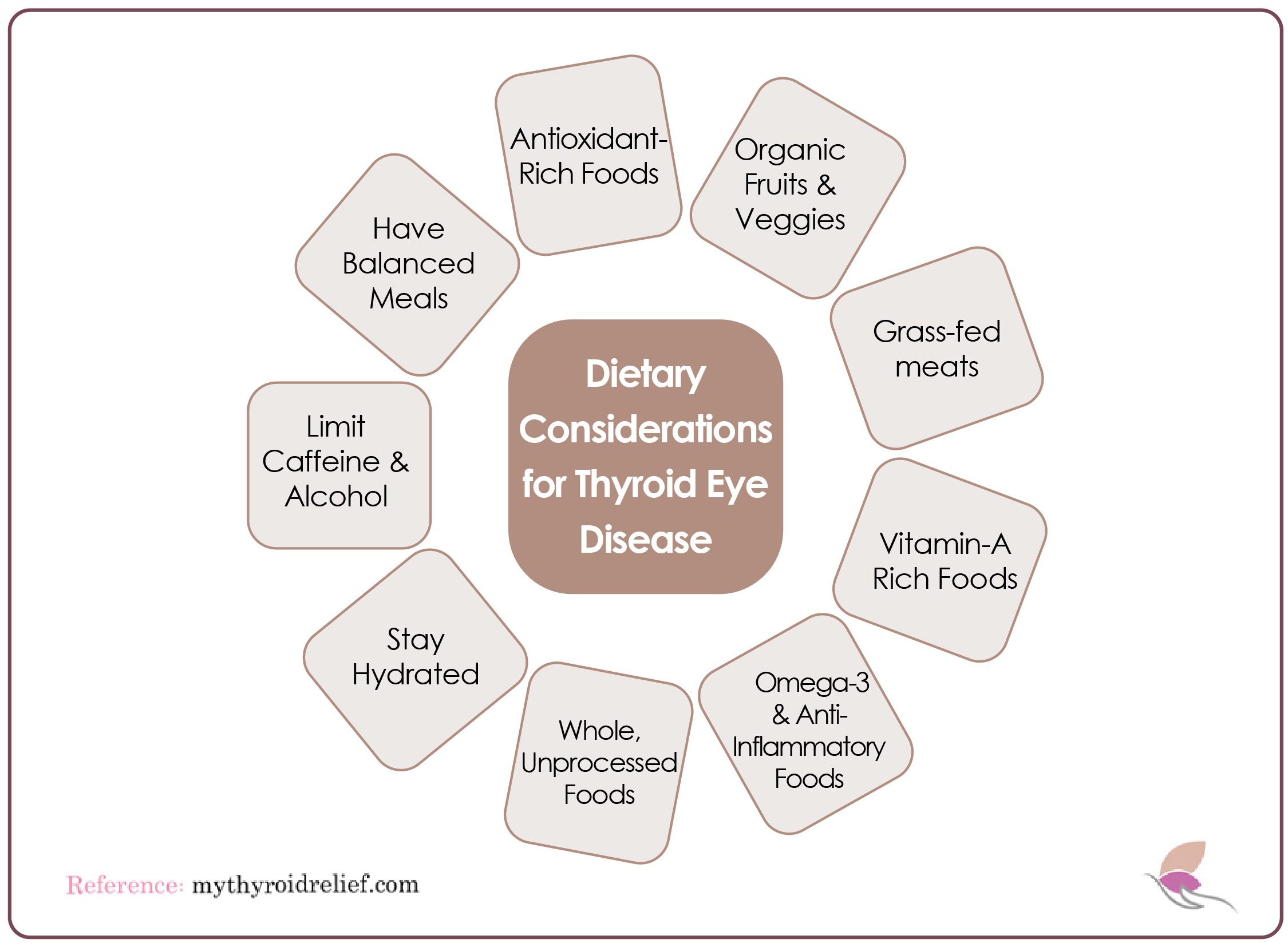
In addition to supplements, a well-balanced diet can significantly improve symptoms and support eye health for individuals with Thyroid Eye Disease (TED). Dietary choices are vital in managing inflammation, maintaining overall health, and potentially alleviating some of the discomfort associated with TED. Incorporating anti-inflammatory foods into your diet is particularly beneficial for managing TED, as they help reduce inflammation around the eyes and promote overall health. Here are some dietary recommendations to consider:
1. Antioxidant-Rich Foods
Antioxidants help neutralize harmful free radicals and reduce oxidative stress, which can worsen TED symptoms. Foods like berries, citrus fruits, spinach, kale, and broccoli are rich in antioxidants and promote overall eye and thyroid health. Including these in your daily meals supports the body’s natural healing processes. Also, consider adding turmeric to your food; it contains curcumin, a powerful anti-inflammatory compound.
2. Organic Fruits & Veggies
Opt for organic produce to minimize exposure to pesticides and harmful chemicals. Berries like blueberries, strawberries, and raspberries are beneficial and packed with vitamins C and E, essential for protecting the delicate tissues around the eyes.
3. Grass-fed Meats
Choose quality grass-fed beef, lamb, organic chicken, and turkey, which are high in quality proteins and healthy fats to avoid harmful toxins and added artificial hormones.
4. Vitamin A-Rich Foods
Vitamin A is essential for maintaining healthy vision and immune function. Sweet potatoes, carrots, bell peppers, and dark leafy greens are excellent sources of beta-carotene, which the body converts into vitamin A. These foods help protect the surface of the eyes and may reduce dryness or irritation associated with TED.
5. Omega-3 & Anti-Inflammatory Foods
Omega-3 fatty acids are known for their anti-inflammatory properties, which can help manage inflammation linked to TED. Wild-caught fish such as salmon, sardines, halibut, trout, and anchovies are rich in omega-3s that support eye and thyroid health. Aim to include these in your diet at least twice a week.
Additionally, other anti-inflammatory foods like chia seeds, flaxseeds, walnuts, and olive oil can further help reduce inflammation. Use healthy fats like olive oil (extra virgin), avocado, and coconut oil for cooking and baking. Also, it is beneficial to drink green tea, as it contains catechins and potent antioxidants that help reduce inflammation.
6. Whole, Unprocessed Foods
Focus on whole grains, legumes, nuts, seeds, and fresh produce to provide steady energy and essential nutrients. Complex carbohydrates and fiber-rich options like quinoa, oats, and brown rice aid digestion and help stabilize blood sugar levels, which is critical for managing thyroid-related symptoms.
7. Stay Hydrated
Hydration is key for overall health and maintaining eye moisture. Drink at least 8-10 glasses of filtered water daily to help flush out toxins and reduce inflammation. Herbal teas like chamomile or green tea can be soothing and offer additional antioxidants.
8. Limit Caffeine & Alcohol
Both caffeine and alcohol can dehydrate the body and aggravate inflammation. Limiting these beverages can improve hydration, and help reduce TED symptoms. Consider replacing them with healthier options like herbal teas or infused water.
9. Have Balanced Meals
Strive for meals that include a variety of food groups. Combining proteins, healthy fats, and carbohydrates ensures your body receives a full array of nutrients, which can help manage TED symptoms more effectively. For example:
-
Breakfast: A smoothie with spinach, frozen berries, macadamia milk, and chia seeds.
-
Lunch: A salad with grilled salmon, avocado, quinoa, and a lemon-olive oil dressing.
-
Dinner: Baked chicken with roasted sweet potatoes and steamed broccoli.
By incorporating these dietary considerations and anti-inflammatory foods, individuals with TED can support their eye and thyroid health, reduce inflammation, and improve their overall well-being. Always consult a healthcare professional or nutritionist to create a personalized plan that suits your needs.
References
- https://my.clevelandclinic.org/health/diseases/17558-thyroid-eye-disease
- https://www.aao.org/eye-health/diseases/what-is-graves-disease
- https://www.mayoclinic.org/diseases-conditions/graves-disease/symptoms-causes/syc-20356240
- https://www.thyroid.org/thyroid-eye-disease/
- https://www.webmd.com/eye-health/graves-eye-defined
This is a very informative post on Thyroid Eye Disease. Raising awareness about this condition and its connection to thyroid health is important. The symptoms and treatment options outlined are conducive for anyone trying to understand or manage TED. Thanks for sharing such valuable information!
Hi Keepey,
Thank you so much! I’m glad you found the post informative. Raising awareness about Thyroid Eye Disease is truly important, and I hope the information on symptoms and treatment options helps those managing TED or seeking to understand it better. Thanks for reading and your thoughtful comment!